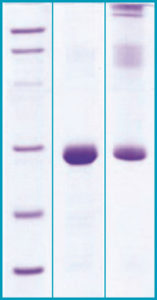Clusterin Rat E. coli
Clusterin is a 75–80 kD disulfide-linked heterodimeric protein containing about 30% of N-linked carbohydrate rich in sialic acid, but truncated forms targeted to the nucleus have also been identified.
The precursor polypeptide chain is cleaved proteolytically to remove the 22-mer secretory signal peptide and subsequently between residues 227/228 to generate the alpha and beta chains. These are assembled anti-parallel to give a heterodimeric molecule in which the cysteine-rich centers are linked by five disulfide bridges and are flanked by two predicted coiled-coil alpha-helices and three predicted amphipathic alpha-helices. Clusterin is a heavily N-glycosylated protein.
Across a broad range of species clusterin shows 70% to 80% of sequence homology. It is ubiquitously expressed in most mammalian tissues and can be found in plasma, milk, urine, cerebrospinal fluid and semen.
It is able to bind and form complexes with numerous partners such as immunoglobulins, lipids, heparin, bacteria, complement components, paraoxonase, beta amyloid, leptin and others. Clusterin has been ascribed a plethora of functions such as phagocyte recruitment, aggregation induction, complement attack prevention, apoptosis inhibition, membrane remodelling, lipid transport, hormone transport and/or scavenging, matrix metalloproteinase inhibition.
A detailed mechanism of clusterin has not been defined. One tempting hypothesis says that clusterin is an extracellular chaperone protecting cells from stress induced by degraded and misfolded protein precipitates.Clusterin is up- or downregulated on the mRNA or protein level in many pathological and clinically relevant situations including cancer, organ regeneration, infection, Alzheimer disease, retinitis pigmentosa, myocardial infarction, renal tubular damage, autoimmunity and others.
Type
Recombinant
Description
Total 240 AA. MW: 26.5 kDa (calculated). UniProtKB acc.no. P05371. N-Terminal T7-Tag and C-Terminal His-tag, 25 extra AA (highlighted).
Source
E. coli
Purity
Purity as determined by densitometric image analysis: >90%
SDS-PAGE Gel
12% SDS-PAGE separation of Rat Clusterin
1. M.W. marker – 14, 21, 31, 45, 66, 97 kDa
2. reduced and heated sample, 10μg/lane
3. non-reduced and non-heated sample, 10μg/lane

Formulation
Filtered (0.4 μm) and lyophilized from 0.5 mg/ml in 20mM Tris buffer, 50mM NaCl, pH 7.5
Reconstitution
Add deionized water to prepare a working stock solution of approximately 0.5 mg/mL and let the lyophilized pellet dissolve completely. Filter sterilize your culture media/working solutions containing this non-sterile product before using in cell culture.
Applications
Western blotting, ELISA
Shipping
At ambient temperature. Upon receipt, store the product at the temperature recommended below.
Storage/Expiration
Store the lyophilized protein at –80 °C. Lyophilized protein remains stable until the expiry date when stored at –80 °C. Aliquot reconstituted protein to avoid repeated freezing/thawing cycles and store at –80 °C for long term storage. Reconstituted protein can be stored at 4 °C for a week.
Quality Control Test
BCA to determine quantity of the protein.
SDS PAGE to determine purity of the protein.
– Dieterle F, Perentes E, Cordier A, Roth DR, Verdes P, Grenet O, Pantano S, Moulin P, Wahl D, Mahl A, End P, Staedtler F, Legay F, Carl K, Laurie D, Chibout SD, Vonderscher J, Maurer G. Urinary clusterin, cystatin C, beta2-microglobulin and total protein as markers to detect drug-induced kidney injury. Nat Biotechnol. 2010 May;28 (5):463-9
– Zhang F, Sha J, Wood TG, Galindo CL, Garner HR, Burkart MF, Suarez G, Sierra JC, Agar SL, Peterson JW, Chopra AK. Alteration in the activation state of new inflammation-associated targets by phospholipase A(2)-activating protein (PLAA). Cell Signal. 2008 May;20 (5):844-61

